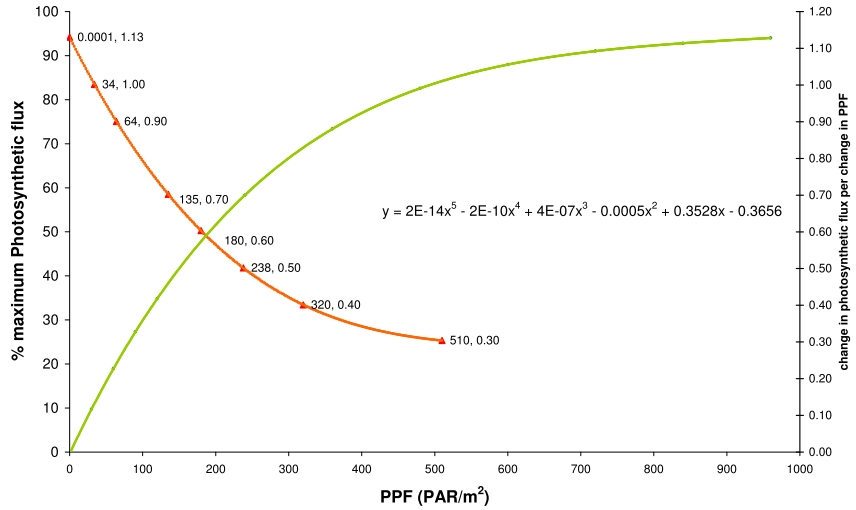Yes and no.
This is a graph I have shown on an Aquarium site:
It is derived from data published by Binzer et al, Limnology and Oceanography, 51:2722-2733, 2006. It refers chiefly to aquarium plants but the basic physiology is the same.
Photosynthesis is limited by the photon flux (measured in microE/m2/s), water and CO2 supply. The curve above grows less and less sensitive to photon flux because the plant has only so many chloroplasts with only so much chlorophyll (CO2 and water are kept constant in the experiments). Eventually the chlorophyll is saturated with light, and then the ADP and NADP are all used up to make ATP and NADPH (which will be used to build sugars by the plant). So yes, eventually increasing the light has no effect, but this is not the case if CO2 and water are limiting.
CO2 enters via stroma on the leaves. Water leaves the plant via stroma on the leaves. If the plant can't take up enough water via its roots to replenish loss through the leaves it will close the stroma and the sugar-synthesizing aspects of photosynthesis will grind to a halt and eventually the chlorophyll will become saturated with light and without enough ADP and NADP it will start producing free radicals and the leaves will burn.
My observation with Disa etc... is that they are always south east facing (so they get the bright morning sun but avoid much of the midday sun and heat). My guess is that Paphs are much the same. They will orientate to get the most sun with the least heat. The more heat, the more water evaporates from the plant tissues. For a few hours of high intensity sun in the morning the plant can generate enough ATP and NADPH to supply all its needs. By midday the bright sun is gone and the plant avoid being roasted by the free radicals produced by the chlorophyll by too much light.
To survive and grow, the plant needs to produce enough sugars from photosynthesis. If it can do this from a few hours of bright sun then that is great for the plant. If it can do it from a whole day of low light then that is great too. The absolute intensity isn't as important as the volume of light needed to meet the plant's metabolic demands.
I find Brachy leaves very interesting. Ever had a good look at them? There is he mottling on the surface and then what looks like a clear layer of tissue and then green tissue underneath. Maybe the plants have their own shade-system to ensure that all their chlorophyll isn't saturated at once? Its very different to the mottling of Barbatum types.
So, the important point here is this: if you can maintain high humidity and adequate water supply, then many of the plant could possibly stand high light all day long; but if you can't, then high light will cook the plants.
Before you redesign your setup, take some plant and place them in different lighting conditions and see how they respond. Back in South Africa you could grow pretty much any Paph under 50--80% shade cloth. This would be about 400--1000 microE of 2000 microE full-summer-sun. To get multies to bloom more light was needed together with more humidity.










